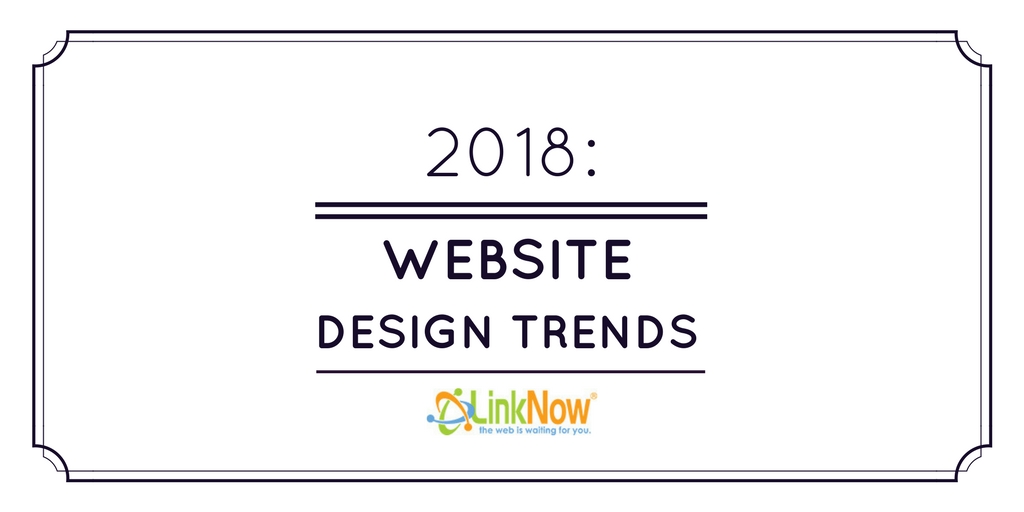
Simply having a website isn't enough in 2018. Take a look at the web design trends you'll need to stand out this year.
Web design's a fast moving industry. With so many factors at play, from new tech to changes in consumer tastes, there's a lot of moving parts to it.You need to know what you're doing before you dive in if you're going to create something you and your users can get any value out of. In today's article, we'll be looking at some of the biggest web design trends of 2018. With these in your arsenal, you'll be at the top of your web design game.
But why take our word for it? Get in touch with us, today, for more on how you can take your online presence to new heights, this year.
In the meantime, join us, as we look at what's going down in web design trends for 2018!
Typography
Where and how to use your lettering. Just because it's a classic design issue, doesn't mean it's not still incredibly important. The size and shape of typography are as big of a concern in 2018 as they've ever been.Companies the world over are incorporating bold fonts that make a statement into their home and landing pages.The idea is to balance this out with simplistic, clean content. The bold typography serves as an anchor, instead of pelting the user with giant letters, with the smaller font toning it down, nicely.
If you're looking for web design trends to help you stand out in 2018, start with typography.
Color Gradients / Transitions
It would be an understatement to say that duotone is making a major comeback in 2018.For those of you not in the know, in the '90s and early 2000s, color gradients were a popular design element. They appeared in website buttons, backgrounds, and all manner of marketing materials. Then they disappeared. The industry switched over to flat, single colors, and the color gradient went the way of the dodo.
Well, we're pleased to inform you that that dodo has returned from the grave.
But with a twist.
Color transitions are becoming a popular filter for photography, instead of being featured on their own.
Take a stock photo from your industry. Something you want to use in your marketing, but maybe isn't all that interesting to look at yet. Apply a soft gradient filter over it, and voilà! You've got a professional looking piece of marketing material, that fits right in with the design trends of the moment. And it's not just for subtle color combinations, either: color gradients are looking wild in 2018. Experiment with some bold colors, and give your website something to help it stand out.
Flat Designs Taking a Backseat
While we're talking about color, let's address the question of flat design.Web design trends in recent years have been to take any unnecessary elements and throw them away. Shades, shadows, rounded edges and embedded movies or sound: all gone, in favor of simple, square, uncluttered designs.That's a design element that's going through some changes.
Minimalism is stepping aside in 2018, and welcoming in the age of the canvas:
These high-quality gifs and videos are set to run on a loop, using your design to create movement on the page. Put them into static web pages, to create something more dynamic for your users to look at.
Micro-interactions
As the user experience becomes more sophisticated, people need simple functions, more than ever. They also want to know, quickly, when something changes On desktops and mobile, we see micro-interactions as web trends becoming increasingly popular.
These are single-use animations, buttons and design elements that affect the way users interact with a website.
Examples of micro-transactions include:
These micro-interactions help to make your site more intuitive for the user to navigate.
Improved Navigation
As we move into the end of the year, we see web design trends of 2017 starting to drop off the design elements of their past. One field where this is quite obvious in navigation.
Specifically, the hamburger menu. Originally introduced to remove information off of a website's homepage, the hamburger menu has been around for years.
The three-lined menu icon found in the top corners of many mobile websites are a great space saver, but they have one very obvious drawback:
They add to the number of clicks a user needs to get to whatever it is they're looking for.In website design, more clicks are almost always worse. Many websites are starting to shift over to a single bar menu at the top of the screen instead of this classic design element, and have been for some time.
Expect to see fewer hamburgers in 2018, but, also, new takes on the classic design. After all, the hamburger menu was designed to save space, and it does that well. It makes sense that designers would want to keep it around, albeit with some improvements. Navigation doesn't need to be kept in the foreground of a website, either.
It's become popular to use pop-out toolbars and hidden menus for maneuvering around a site. This keeps the site clean, showing off all the hard work you've put into your design while giving the user a full range of controls over what they want to do.
A word of caution on this idea: make sure you keep your tools obvious, even when they're hidden. It doesn't help to tidy up your landing page by moving the buttons out of the way if nobody can find them.
Conversational Interfacing
AI's not exactly a new concept. Everything from operating systems to video games has been aping the idea since before the turn of the millennium. What you need to know about AI web design trends in 2018, though, is that they're slowly becoming more common than they've ever been. It all comes down to communication. People are using websites like Facebook and Slack to communicate via text more and more.
And, with bots becoming more realistic every year, sales automation is set to become fully automated sooner rather than later. What does this change about the design of your website? Not much, practically, but it should influence how you think about what you include in that design.
Conversational bots are a useful tool for setting yourself apart, especially if you use them to address the actual needs of your users. Incorporating machine learning into the way these bots operate is a great way to give yourself a competitive edge, design wise.
360 Videos and VR
2016 was a good year for VR. Hemingway Editor Increased virtual reality development and marketing saw sales of headsets and apps skyrocket. More people began using this tech than ever before, bringing it into the mainstream. With the launch of the refined Hololens in 2017 and improvements in WebVR support, 2018 doesn't show any signs of slowing this trend.
And then there's the question of 360 videos. With big name sites like YouTube leading the way in VR and 360-degree video support, the tech still hasn't reached a lot of the lower-rung websites.
Browser-based VR experiences are set to become the next big thing in web design trends, this year. Make sure you're ready for when it does.
Go Mobile (If You Haven't Already)
If this seems obvious for you to read, imagine how we feel having to say it:
Web design trends for 2018 will include mobile development. In fact, web design trends for the next few years will likely be the same. Mobile phones and tablets overtook conventional desktop computers for website views as early as 2016. If you aren't optimized for mobile, you're missing more than half your opportunities to connect with users. Mobile-first design has been prioritizing device-driven traffic for a while now. It's predicted to be a big factor in web development in 2018.
Emerging Web Design Trends for 2018
And there you have it. That's the year in web design trends. While 2017 may not have beena year of many new breakthroughs in web development, it does promise to develop on a lot of the ideas of 2016 and 2015.
How can you start taking advantage of these trends? From making your website design more fun, to bringing 360 videos and VR onboard, there's a lot you can do to get in line with web design in 2018. But what are your thoughts? Did we cover everything you've been using to improve your user experience, so far, this year, or was there something we forgot? Let us know in the comments section, below.


Amazing analysis and very intelligent work done by you. As per my point of view, among all of these trends will be helpful in 2018.